- Budapest goes 3D: The Budapest Times reports that the city’s mayoral office is subsidizing the creation of 3D models of landmarks for inclusion in Google Earth. While the article is off when it comes to which other cities have 3D cores (see Frank’s post about recent updates) it is interesting to see how creative new ways are being used to finance putting a city’s best face forward:
Private corporations are welcome to “adopt” a district, thereby financing the production of the virtual version of the particular area.
- Tasmania councils nix Google Earth surveillance: On Tasmania, some local governments say that neighbours ratting on each other over property violations is more efficient and less intrusive than using Google Earth for policing. In which case, I suggest that tasmania’s neighbours use Google Earth to check on each other and then rat to the local council thus. I’m sure that would work even better:-)
- Google Earth Hacks goes mobile: Google Earth Hacks now has web pages that are optimized for smartphone browsers. Go to m.gearthhacks.com and you can now browse the site’s locations on a small screen, with Google Maps URLs opening in the dedicated Google Maps application on the iPhone. You can’t view overlays or 3D models on the iPhone, of course, and you can’t search (just drill down categories), but by making much of its content available to the mobile browser today, Google Earth Hacks is ahead of what I expect will be quite a big curve:-)
- Get on your bike: In cities like Paris, Montreal and Stockholm, you can set up an account online, then take a bike from any number of automated bike “stations”, bike around as long as you like, and return them at another station near your destination, paying cheap rates. It’s a brilliant system, but it depends on you, the pedestrian, knowing where the nearest stations are. That makes for a wonderful opportunity to exploit location-aware devices like the iPhone: GoVelib tells you, based on your location, where the five nearest bike stations are in Paris, and how far away.
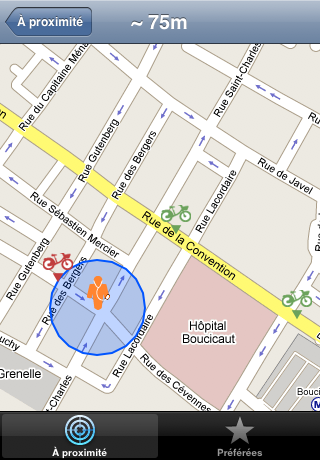
- Microsoft & spatial computing: According to Microsoft Chief Research and Strategy Officer Craig Mundie, the future of computing will involve “a 3D virtual world populated by virtual presences, using a combination of client and cloud services,” writes Dan Farber on his blog, reporting from the MIT Emerging Technology Conference last week. Photosynth also makes an appearance. The blog post links to some interesting YouTube videos, well worth watching if you want to know where Microsoft thinks we’re all headed. (Via Slashdot)
- Flash Forward: For a sneak peek of what Flash can do in the realm of 3D visualization, check out some amazing demos made by the Amsterdam-based duo Barcinski & JeanJean: A panorama “photograph” where the perspective changes as you rotate left and right, 3D pong, a wave generator and a 3D line you direct yourself. Not GIS-related, but surely this is fertile grounds for inspiration. Here is their blog.
- Hosted satellite imagery for gov: An interesting business idea, as reported by New Zealand’s Computerworld:
Wellington GIS specialist e-spatial and valuation and property information company Quotable Value are setting up a hosted service for satellite imagery for central and local government.
All of New Zealand is available in 50cm resolution direct from the companies’ servers, instead of agencies needing to acquire and maintain a copy themselves. Why not just give it to Google and work off that? I suspect the licensing is more amenable to government, though the service is still NZD 70,000 a year (USD 50,000, EUR 33,500). Also: How come the data is available as WMS but not KML?
All posts by Stefan Geens
GeoCommons Maker!, Finder! launched

FortiusOne‘s GeoCommons is a free web-based geospatial analysis and cartography tool that also allows you to upload, share and remix datasets, and it is being relaunched today. It packs quite a punch.
But first some history. GeoCommons was originally launched at Where 2.0 in 2007. Over the past year, feedback from neogeographers who most need such a service led FortiusOne to completely redesign the service, and also to team up with Mapufacture, who have been working on similar technologies and goals.
The result is the new GeoCommons, which I’ve had a chance to play with over the past few days. It’s easy to explore — just get a free account and start mapping with heaps of existing datasets, or upload your own.
What makes GeoCommons so intuitive is that the service’s two main functions are clearly delineated — there’s Finder! for “finding, organizing and sharing GeoData in common formats” and Maker! to “make stunning interactive maps with your own data, GeoCommons public data or both.”

Finder organizes the raw content, while Maker deals with the presentation of this content, though the tools that let you make a cool map aren’t just collections of pretty icons, but include nifty widgets for slicing the data so as to maximize clarity. For example, choosing the dataset of recent earthquakes is just the beginning. You then get to massage the data thus before it makes it to the map:



That’s a level of sophistication in end-user web-based geotools I have not seen anywhere else. The best thing is that subsequent users can try their own hand at manipulating the data within the map, or make a completely new map with the same data.
Geocommons is also agnostic when it comes to your basemap:
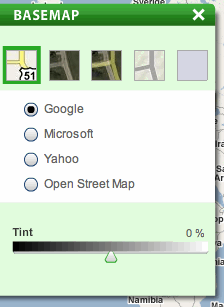
How can it possibly get better? Well, you can currently link to a map, but you can’t yet embed it on a web page elsewhere on the web. FortiusOne’s Sean Gorman says they have embeddable maps waiting in the wings, but don’t want to burden the servers with it just yet.
Also, if you want to get a dynamic KML network link to the data, you currently have to go via a map rather than directly from a data layer, but that too is just temporary. Writes Sean:
All the KML on Finder is raw data and not network links. So you can only upload raw KML and download raw KML and there is not currently network link support. We are currently working on support for dynamic data that would allow us to support both KML network links and GeoRSS but do not have it ready for launch. This is a big part of what we are doing with the merging of Mapufacture into GeoCommons.
And at the moment, you can’t upload KMZ files yet — they have to be KML, which means you can’t upload overlays. You also can’t upload KML files that reference overlays as URLs. But these are quibbles; GeoCommons takes Shapefiles and all CSV spreadsheets with longitude and latitude columns, and you can also download GeoCommons layers as KML, Shapefiles or CSV spreadsheets.
Have fun exploring this significant new neogeo toolset. As soon as GeoRSS and network link support for datasets is in place, imagine the things you will be able to do with GeoCommons married to Yahoo! Pipes:-)
{Update 13:42 GMT: Mapufacture’s Andrew Turner blogs Maker! and the goals behind this app.]
[Update 14:07 GMT: Sean Gorman blogs the launch.]
Links: Mapping astronomy papers; Virtual Earth for iPhone how-to, Wasilla “censorship” debunked
I’m going to try to stay awake for the US presidential debates, which go live here in Cairo at 3am, so in the meantime here is another round of interesting links with commentary:
- Auto-mapping astronomy paper references: the Daily ACK’s Alasdair Allen comes up with yet another ingenious KML hack for astronomers: All papers in the Astrophysics Data System (ADS) database that contain reference links to astronomical objects in the massive SIMBAD database can now be mapped via his script to a KML file that is viewable in Google Sky. At the moment it’s a perl script that you’d have to implement yourself, but here’s hoping that this becomes a web service real soon, linked to automatically from ADS queries. Alasdair also muses as to further possible data mining possibilities:
If you had a large enough group of astronomers, and therefore a large enough number of papers, you could produce heat maps of the sky instead of using simple push pins. You could cross-correlate your own publications with that of a group or institute where you’re thinking of applying for a job, or the publication output of a survey team with the footprint of their survey…
- Stellarium updated: Talking of astronomy, really excellent open source desktop planetarium Stellarium just got a major update. It’s even prettier than before.
- Virtual Earth on iPhone how-to: So that I can get a bird’s eye view application on my iPhone faster, Chris Pendelton has written up a how-to for you, developer. If anybody knows of any apps out in the wild, or even Virtual Earth web maps that are mobile-savvy and accessible via a URL, please let me know.
- Debunking censorship myths in Wasilla & Boston: Xconomy’s Wade Roush debunks the latest censorship urban myth:
One rumor making its way around the Web right now is that Google blurred out images of Wasilla, AK, after Alaska governor and former Wasilla mayor Sarah Palin was named John McCain’s running mate.
As Wade points out, the reality is that a DigitalGlobe high resolution tile happens to cover half of Wasilla, while the other half is at 15m meter resolution, like most of Alaska (it being a big state). No conspiracy here.
But Wade also fact-checks that now-infamous IT Security article Blurred Out: 51 Things You Aren’t Allowed to See on Google Maps for all the places it says are censored near Boston. Surprise surprise, none of them are. He has a good theory as to why that article was so off-base — it was uncritically cribbed from a Wikipedia article that is itself not reliably sourced.
- Afrigadget: Only tangentially related to GIS, but a new favorite blog of mine is Erik Hersman’s Afrigadget, via Ethan Zuckerman, who drives home the fact that “Africa’s an amazing lab for innovation, because if it works in Africa, it will work anywhere.”
- Thematic Mapping Engine: Better mentioned late than never on this blog, the Thematic Mapping Engine is an impressively polished global statistics visualizer for such indicators as mortality rates, CO2 emissions, internet usage and much more, mapped across the world’s countries as KML — even as a time series, where the data is available.
Crowdsourcing free Cairo wifi with Google My Maps
Cairo blogger and friend Elijah Zarwan, aka The Skeptic, has been lamenting the demise of widespread free wifi in Cairo’s cafés, now mostly replaced by a monopolistic pay-as-you-go registration system that also happens to make it more difficult for Cairo’s burgeoning blogging classes to criticize the government anonymously.
A crowdsourcing experiment was in order, so I started a Google My Map that anyone can edit to add the locations of those cafés and locations that are bucking the trend and deserving of everyone’s business. The map’s home page is here, but you can of course embed it like so:
It’s early days yet, but anyone can make it better: You just need a Google account, but that account can of course be anonymous.
One concern: Malicious users could erase the data, and this is one area where Google Maps could be improved: Allow only non-destructive edits by collaborators, and add admin privileges for map owners, so that they can review all edits and destructive edit requests. In the meantime, I’m backing up the map regularly by copying the data to a private My Map. (That leads to another feature request: versioning)
Links: DigitalGlobe contract, Baghdad by night, Kosi river flood imagery
- DigitalGlobe, Google, extend agreement: It’s described by DigitalGlobe in their press release as a “new multi-year, non-exclusive content agreement”. I wonder if that means the terms have been changed. The previous agreement gave Google exclusive web use of the imagery.
- Iraq Surge “success” due to ethnic cleansing? Science Daily writes up an analysis of satellite imagery of Baghdad taken at night which concludes that several Baghdad neighborhoods saw distinctive reductions in night light over the past few years – a proxy for population density. The inference is that the depopulation of these neighborhoods is a cause for the lessening of the inter-community violence in Bagdhad, as there are fewer mixed communities left. It’s a feasible thesis, though to me the unit areas measured in the analysis look rather large and coarse for any definitive conclusions to be drawn.
- The Google Earth censorship meme continues to spread: Emirates Business 24/7 believes that
Google Earth is also victim to this arm-twisting tactics of authorities and, on the request of many countries, blocks geographical imprints of sensitive areas. Largely disputed areas are also blocked on Google Earth on the request of respective countries.
I’m glad that UAE media pens articles critical of internet censorship (and some of the other points are spot on) but facts are facts and the above excerpt is fiction.
- India flooding gets updated imagery: The flooded Kosi river now has some proper updated imagery, thanks to the German Aerospace Center (DLR), GeoEye and the Google India Team.
- Virtual Earth v6.2 now out: The new map controls for Microsoft Virtual Earth are out. In this version developers get much better support for mobiles. I can’t wait to get bird’s eye view on my iPhone — until now, Virtual Earth wasn’t usable in the mobile browser. Alas, 3D still doesn’t work on Macs. (Talking of which, the Google Earth 3D plugin for Mac browsers still isn’t out yet either.)
The state of 3D on the iPhone
So how close are we to getting a proper 3D virtual globe on the iPhone?
Clearly, recent apps for the iPhone have shown that true 3D games are entirely doable: Just take a look a Cro-Mag Rally to see a car racing game using real-time 3D rendering of the terrain.
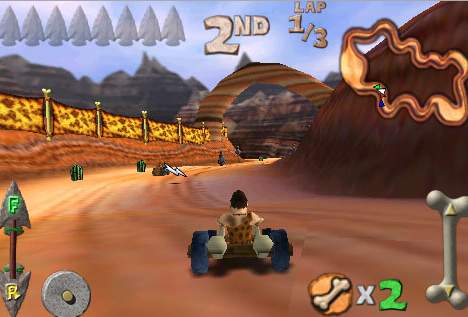
No doubt plenty of short-cuts are employed for the sake of playability, and the terrains are fantasy places, but the player does get a sustained effect of being inside a 3D place rather than looking at a 2D screen. Same goes for Aphalt 4.
Then there is an actual stab at making a virtual globe: Earthscape does a remarkable job of hiding its shortcuts to create quite a seamless experience. You can zoom in on the globe from above, and then switch to a stationary bird’s eye view to see a 3D terrain view. Both modes get around what must be a very expensive calculation, in terms of processing power: Deciding which 3D pixels come in front of others. In the straight-from-above view, no such calculations are necessary as you zoom in, as you always get to see every pixel on the map, even if it is a 3D map (just travel across the Alps at close range to see the changes in perspective). When you switch to the bird’s eye view perspective, the application spends some time figuring out which pixels come in front of others for your one specific location — and it only needs to do this once, as you can’t look up to the horizon and then travel. In effect, what Earthscape does is construct a 360-degree panorama for your location and then lets you pan and zoom around that. All the work, however, only needs to be done once. You can’t move location while looking around in bird’s eye view. (see comments for clarification.)
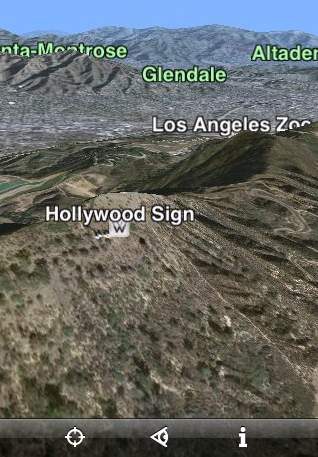
Earthscape is an impressive proof of concept, a good app to impress iPhone newbies with. It does suffer from some limitations, currently, that don’t really make it usable as an efficient cartographic tool: It takes a very long time for the resolution to catch up with your zoom, even on wifi broadband; and while some US cities have high resolution imagery, Europe and the rest of the world does not. As a result, the Wikipedia layer included in Earthscape has a much higher level of granularity than the map it is displayed on.
In a way, these criticisms are a bit unfair, as we’re comparing Earthscape to the imagery dataset and data serving capacity of some of the world’s biggest companies, but they do reflect user expectations. I’m sure we can expect future updates to Earthscape to get road layers as well.
In one respect Earthscape has a feature that Google Earth and Virtual Earth haven’t even implemented: A feed of popular photo site Flickr’s “most interesting” georeferenced pictures. There is also a built-in feature to take and upload geotagged iPhone pictures to an Earthscape server, and the ability to see these photos and the most recent ones uploaded by everyone on Earthscape, but these are — for the moment at least — snapshots of people testing the feature. Flickr and Panoramio have proper “postcard” photos.
In sum: At its previous price of $10, I couldn’t really recommend Earthscape as money well spent (other than to review it), but at its current new price of Free, there is every reason to download it, play with it, and offer feedback to encourage further development.
Can we expect to get “live” bird’s eye view soon, in the sense that a 3D view towards the horizon is calculated in real time as we travel across the landscape? [Update: See comments; Earthscape does already let you move around] One iPhone application already does this, and with impressive frame rates: X-Plane 9.
X-Plane is a joy to use as a flight simulator (once you realize that it crashes easily if it doesn’t get to use plenty of unfragmented memory, i.e. restart the iPhone before use). The accelerometer-based controls are especially intuitive, and I hope future mobile virtual globes let us navigate the world in a similar fashion. The most impressive feature of Xplane for iPhone is that it uses the same bit of real terrain as in the full-fledged version (according to Xplane aficionados): The region around Innsbruck, Austria. It’s mountainous, and yet rendered in real-time. And it is $10 well-spent.
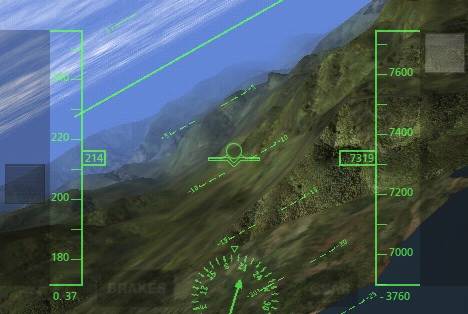
Can this be replicated in a virtual globe? There are three short-cuts that I can see that may make it harder for virtual globes to get the same frame rate as X-Plane: 1) the terrain is not downloaded on demand but instead already exists in memory; 2) the textures are quite rough and limited in variety; it seems to me that there is only one level of detail; 3) Plenty of haze ensures that the 3D pixel calculations don’t have to extend too far from the cockpit.
Still, it certainly looks feasible that a true virtual globe is within reach of the iPhone’s capabilities, and I for one can’t wait to play with it.
GRB 080913 – a burst of perspective
On September 13, a whole week ago, back when we were busy being consumed by the possibility of financial armageddon or the meaning of lipstick on a pig, something flitted past Earth that tends to put all that into perspective: Evidence in the form of electromagnetic radiation of a high-energy explosion that took place 12.8 billion years ago — making it the oldest and furthest gamma ray burst ever recorded, from when the universe was only 7% of its present age.
The recording was done by the Swift satellite, which is automated to quickly lock on and zoom into such events. This particular burst, GRB 080913, had a redshift higher than anything Swift had seen previously. Space.com has the story with a good image of the burst, NASA has the raw data including coordinates, and Swift’s site has raw imagery data with grid overlays (try the GIFs) so it didn’t take long to create an overlay for Google Sky. Here it is.
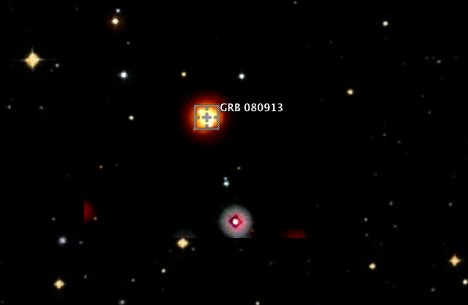
(In March 2008, Swift caught the most luminous gamma ray burst so far, coincidentally within hours of Arthur C Clarke’s death. That burst was 7.5 billion light years away. GRB 080913 is more than half that again older and further away.)